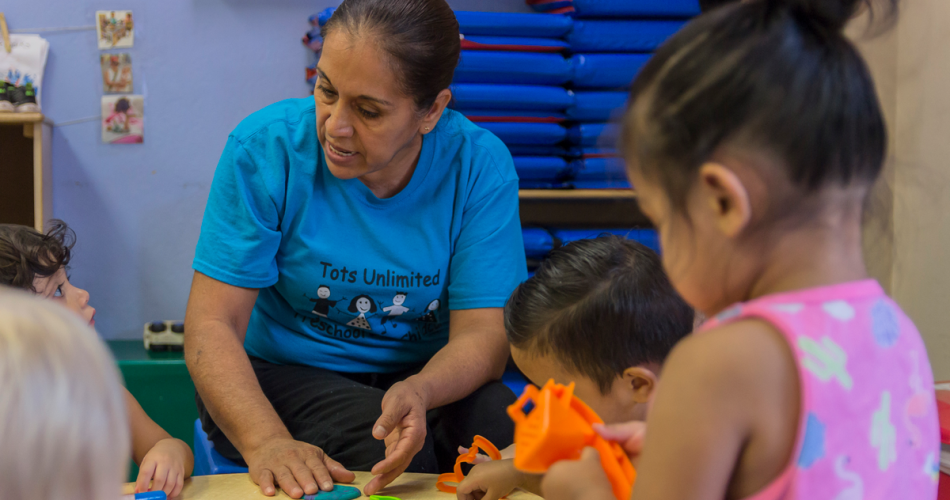The Quality First Assessment team provides informal assessment to offer objective feedback using the updated, third editions of the Environment Rating Scales (ERS) tools. This opportunity is available to licensed child care providers, including family child care and center-based programs serving children birth to age 5 in Arizona. Informal assessment provides you the opportunity to experience the process of Quality First Assessment without impacting your Star Rating. This process can be especially helpful to support your learning about the updated editions of the assessment tools, and to help teaching staff become more comfortable with the observation process. You choose the classroom and timeframe that works best for your program.
This month we spoke with two Quality First participants about their experiences using the written informal reports they received following their informal assessment observations. Both directors received feedback through the lens of the newly updated, third editions of the Environment Rating Scales. Read our interview with these professionals who are using their informal feedback to maximize their continuous quality improvement efforts.
How do you use the written informal feedback at your program?
Amanda Ayon, director at Erik Hite Foundation Child Care Center, said, “Any feedback that we receive informal or formal, will help me to see what our program needs to work on and where we can grow. The teachers are dedicated to the trainings and going to school to learn more about how they can improve themselves at doing their job. For this last informal assessment, one of my teachers asked every week about the results, so she could look at them. We are eager to learn more for our center.”
Jennifer Garcia, director at A New Leaf’s Phoenix Day, said, “I will be sharing our feedback at a smaller meeting during a classroom supervision session with the staff in the assessment. We will review the strengths and assets we bring to our children and classrooms. We will look at areas we can focus on improving and divide them into groups. For example, we will look at immediate remedies, such as things we can purchase to enhance our environment, things to remove or replace, etc. We’ll also look at the long- term goals that will need additional coaching, teaching and training support. A meeting will be scheduled with our Quality First support team to see how the goals we have been working on have supported our staff and children, and what new goals we can put in place.
Garcia continued, “Information will be shared during meetings about our strengths, so we can share ideas and give kudos where they are due. Sharing what one does well or has mastered gives a real-life model of how others could adopt strategies that work. They provide a sounding board for each other’s ideas and offer peer encouragement. I empower my staff to reach out to each other and we often internally assess other classrooms for this reason.”
What, if anything, was the biggest surprise as you reviewed your informal feedback?
“The biggest surprise that I received was the scoring we got,” said Ayon. “In the past we have done really well on the assessment, so to receive the results that we got back, was a shock. I learned that the assessment was done using the updated, third edition version of the ERS tool, which we have not used in the past. Based on the feedback, now I know where to begin working with the teachers. I am already in the works of contacting my QF coach so I can ask about the new ERS-3 books and new training opportunities, so that we can begin to train the staff before our next formal assessment.”
What advice would you give another provider who was getting ready to read their informal feedback?
“Don’t take the results to heart,” said Ayon. “If you didn’t have any idea about the new ERS tools or are barely starting out with this new information, then your results will not be great. This informal assessment gives us opportunities to learn new ways and to get feedback. Touch base with your assessors to talk about your concerns because they are open to answering questions the best that they can.”
Garcia said, “Read it first and then let it marinate a day or two as you ponder how to best share this information. I utilize a color personality quiz to adapt and individualize my feedback approach to each classroom and individual staff member. Any particularly hard feedback to deliver would be one-on-one to respect my staff where they are in the learning process. I think knowing that you are doing your best allows me and my staff to take in the feedback for what the intention of it really is–to help us see the good in our people and our place. To help us see how close we are to becoming better by making small changes. To help us map out how we can incorporate big changes to achieve our ultimate goal over time for things that need time to really implement.”
How to request informal assessment
Quality First participants may visit the Extranet’s Quality First Resources and select “Quality First Forms” to find the Informal Assessment Request form. Instructions for submittal are included on the form.
Early care and education programs that are not enrolled in Quality First may contact the Quality First Assessment Program Manager Katie Romero to submit a request. Email kromero@swhd.org or call 602.633.8652.
At Quality First, we love to hear from you! Share your new and innovative practices so others can be inspired. Send an email to QualityFirst@FirstThingsFirst.org.
